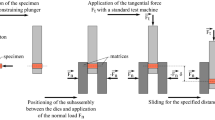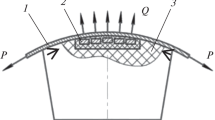Abstract
Analysis of how the size of the tribocontact influences temperature rise in the contact zone has revealed that the maximum temperature rise in tribocontact with micro- and nanodimensions does not exceed 10 K. As the contact zone shrinks, each surface point is in contact for a shorter time so that the thermal activation leaves various friction-induced processes in the contact zone more or less unaffected. Thus, there should be athermal processes of activation of tribostimulated phenomena. The athermal mechanisms are considered that are likely to activate tribodesorption of gases and triboluminscence.
Similar content being viewed by others
References
Buyanosvskii, I.A., Fuks, I.G., and Bogdasarov, L.N., Ocherki po istorii tribologii (Sketches of Tribology History), Moscow: Neft’ i Gaz, 1998.
Bowden, F.P., and Tabor, D., Trenie i smazka tverdykh tel (Friction and Lubrication of Solids), Moscow: Mashinostroenie, 1968.
Walton, A.J., Triboluminescence, Advances in Physics, 1977, 26, no. 6, pp. 887–948.
Evdokimov, V.D. and Semov, Yu.I., Ekzoelektronnaya emssiya pri trenii (Exoelectron Emission in Friction), Moscow: Nauka, 1973.
Deulin, E.A. and Peresad’ko, A.G., Diagnostika i prognozirovanie otkaza vysokovakuumnykh mekhanizmov (Diagnostics and Prediction of Failure of High-Vacuum Mechanisms), Kontrol’. Diagnostika, 1998, no. 5, pp. 21–28.
Pogodaev, L.I. and Kuz’min, V.I., Strukturno-energeticheskie modeli nadezhnosti materialov i detalei mashin (Structural Energy Models of Reliability of Materials and Machine Parts), Saint-Petersburg: Akad. Transp. RF, 2005.
Heinike, G., Tribokhimiya (Tribochemistry), Moscow: Mir, 1978.
Kragel’skii, I.V., Lyubarskii, I.M., and Guslyakov, A.A., Trenie i iznnos v vakuume (Friction and Wear in the Vacuum), Moscow: Mashinostroenie, 1973.
Bulgarevich, S.B., Kontaktnoe vziamodeystvie i sukhoe trenie (Contact Interaction and Dry Friction), Moscow: Mosk. Gos. Tekh. Inst. N.E. Baumana, 2005, pp. 60–67.
Butyagin, P.Yu., Problemy i perspektivy mekhanokhimii (Problems and Prospects of Mechanochemistry), Usp. Khim., 1994, vol. 63, pp. 1031–1043.
Varentsov, E.A. and Khrustalev, Yu.A., Mekhanoemissiya i mekhanokhmiya molekulyarnykh organicheskykh kristallov (Mechanoemission and Mechanochemistry of Molecular Organic Crystals), Usp. Khim., 1995, vol. 64, pp. 834–839.
Poverkhostnaya prochnost’ materialov pri trenii (Surface Strength of Materials in Friction), Ed. B.I. Kostetskii, Kiev: Tekhnika, 1976.
Nevshupa, R.A., Triboemission: an Attempt of Developing a Generalized Classification, Proc. Conf. “Tribology: Science and Applications”, Vienna: PAS, 2003, p. 14.
Dickinson, J.T., Langford, S.C., and Jensen, L.C., Fractoemission from Fused Silica and Sodium Silicate Glasses, J. Vac. Sci. Technol. Ser. A, 1988, vol. 6, pp. 1084–1089.
Gutman, E.M., Mekhanokhimiya metallov i zashchita ot korrozii (Mechanochemistry of Metals and Protection from Corrosion), Moscow: Metallurgiya, 1974.
Fox, P.G. and Soria-Ruiz, J., Fracture-induced thermal decomposition in brittle crystalline solids, Proc. Royal Soc., 1970, vol. 317, pp. 79–80.
Dickinson, J.T., Jensen, L.C., Langford, S.C., and Rosenberg, P.E., Fracture-Induced Emission of Alkali Atoms from Feldspar, Phys. Chem. Min., 1992, vol. 18, pp. 453–459.
Dickinson, J.T., Jensen, L.C., and Langford, S.C., Atomic and Molecular Emission Accompanying Fracture of Single-Crystal Ge: a Dislocation Driven Process, Phys. Rev. Lett., 1991, vol. 66, pp. 2120–2123.
Dickinson, J.T., Jensen, L.C., Langford, S.C., and Dion, R.P., Temperature Measurements of the Gaseous Emission During the Fracture of Polystyrene: a Determination of the Fracture Energy and Fracture Surface Temperature, J. Polymer Sci. Ser. B., 1994, vol. 32), pp. 779–782.
Dickinson, J.T., Jensen, L.C., and Dion, R.P., Fractoemission from High-Density Polyethylene: Bond Breaking Versus Tribological Stimulation, J. Appl. Phys., 1993, vol. 73, pp. 3047–3054.
Kim, M.-W., Langford, S.C., and Dickinson, J.T., Emission of Neutral Mg from Single Crystal MgO During Abrasion with Diamond, J. Appl. Phys., 2003, vol. 93, pp. 1819–1825.
Dickinson, J.T., Jensen, L.C., Langford, S.C., and Hirth, J.P., Atomic and Molecular Emission Following Fracture of Alkali Halides: a Dislocation Driven Process, J. Mat. Res., 1991, vol. 6, pp. 112–125.
Dickinson, J.T., Jensen, L.C., Langford, S.C., Rosenberg, P.E., and Blanchard, D.L., CO2 Emission Accompanying the Fracture of Calcite, Physics and Chemistry of Minerals, 1991, vol. 18, pp. 320–325.
Urakaev, F.Kh., Pozdnyakov, O.F., Boldyrev, V.V., and Savintsev, Yu.P., Kinetika i mekhanizm vydeleniya letuchiikh produktov pri raskalyvanii monokristallov neorganicheskykh soedinei (Kinetics and Mechanism of Release of Volatile Products when Monocrystals of Inorganic Compounds Crack), Kinetika i Kataliz, 1978, vol. 19, no. 6, pp. 1442–1447.
Urakaev, F.Kh. and Boldyrev, V.V., Korrelyatsiya vykhoda letuchikh produktov s parametrami rasprostraneniya khrupkoi treshchiny v kristallakh (Correlation of Release of Volatile Products with the Parameters of Brittle Crack Propagation in Crystals), Zh. Fiz. Khim., 2000, vol. 74, no. 8, pp. 1483–1488.
Urakaev F.Kh., Mechanodestruction of Minerals at the Crack Tip (Overview): 1. Experiment, Physics and Chemistry of Minerals, 2007, vol. 34, pp. 351–361.
Frisch, B. and Thiele, W.-R., The Tribologically Induced Effect of Hydrogen Effusion and Penetration in Steels, Wear, 1984, vol. 95, pp. 213–227.
Ikoma, T., Zhang, Q., Saito, F., et al., Radicals in the Mechanochemical Dechlorination of Hazardous Organochlorine Compounds Using CaO Nanoparticles, Bull. Chem. Soc. of Japan, 2001, vol. 74, pp. 2303–2309.
Louthan, M.R., Jr., Caskey, G.R., Donovan, J.A., and Rawl, D.E., Jr., Hydrogen Embitterment of Metals, Material Science and Engineering, 1972, vol. 10, pp. 357–368.
Nakayama, K., Nevshupa, R.A., Plasma Generation in a Gap Around a Sliding Contact, J. Phys. Ser. D: Appl. Phys., 2002, vol. 35, L53.
Nevshupa, R.A., Scherge, M., and Ahmed, S.I.-U., Transitional Microfriction Behavior of Silicon Induced by Spontaneous Water Adsorption, Surface Science, 2002, vol. 517, pp. 17–28.
Tian, X. and Kennedy, F.E., Jr., Maximum and Average Flash Temperatures in Sliding Contacts, ASME Journal of Tribology, 1994, vol. 116, pp. 167–174.
Chichinadze, A.V., Raschet i issledovanie vneshnego treniya pri tormozhenii (Calculation and Investigation of External Friction in Braking), Moscow: Nauka, 1967.
Groszkowski, J., Gas Desorption at Rubbing Surfaces in High Vacua, Bulletin de l’Academie Polonaise des Sciences, 1961, vol. IX, no. 2, pp. 111–112.
Řepa, P. and Rott, M., Outgassing of Metals Stimulated by Friction, Vacuum, 1997, vol. 48, pp. 775–778.
Řepa, P., Mechanically Induced Desorption, Vacuum, 1992, vol. 43, pp. 367–371.
Kuzhman, A.G., Chernyshova, E.Yu., and Shapkin, E.V., Issledovanie friktsionnykh kharakteristik tverdosmazochnogo pokrytiya VNII NP 220 v atmosfere i vakuume (Study of the Friction Characteristics of the Solid Greasing Coating VNII NP 220 in the Air and in the Vacuum), Tr. Mosk. In-ta Elektr. i Mat., 1974, vol. 42, pp. 110–124.
Mori, S., Kawada, T., and Xu, W.C., Tribochemical Decomposition of Formic Acid on the Nascent Surfaces of Steel Formed by Scratching, Appl. Surf. Sci., 1997, vol. 108, pp. 391–397.
Nevshupa, R., de Segovia, J.L., and Roman, E., Surface-Induced Reactions of Absorbed Hydrogen Under Mutual Mechanical Forces, Vacuum, 2005, vol. 80, pp. 241–246.
Peressadko, A.G., Nevshupa, R.A., and Deulin, E.A., Mechanically Stimulated Outgassing from Ball Bearings in Vacuum, Vacuum, 2002, vol. 64, no. 3–4, pp. 273–278.
Nevshupa, R.A., de Segovia, J.L., and Deulin, E.A. Outgassing of Stainless Steel During Sliding Friction in Ultra High Vacuum, Vacuum, 1999, vol. 53, pp. 295–298.
Deulin, E.A. and Nevshupa, R.A., Deuterium Penetration into the Bulk of a Ball Bearing due to its Rotation in Vacuum, Applied Surface Science, 1999, vol. 144–145, pp. 283–286.
Deulin, E.A., Goncharov, S.A., de Segovia, J.L., and Nevshupa, R.A., Mechanically Stimulated Solution of Adsorbed Hydrogen and Deuterium in Steel, Surface and Interfacial Analysis, 2000, vol. 30, pp. 635–637.
Fujii, J. and Ishimaru, H., Desorption from Ball Bearing in Ultra High Vacuum, J. Vac. Sci. Technol., 1991, vol. A9, pp. 2017–2020.
Řepa, P. and Orálek, D., Outgassing Stimulated by Deformation, Vacuum, 1999, vol. 53, pp. 299–302.
Dushman, S., Nauchnye printsipy vakuumnoy tekhniki (Scientific Principles of Vacuum Technology), Moscow: Mir, 1964.
Thomas, L.C., Heat Transfer, Tulsa: Capstone Publishing Corp., 1999.
Tuzi, Y., Kurokawa, Y., and Takeuchi, K., Effect of Bake-Out on the Adsorption Kinetics of Gases in a Vacuum Chamber, Vacuum, 1993, vol. 44, pp. 447–449.
Moraw, M. and Prasol, H., Gas Desorption from a Stainless Steel Surface in Ultra-High Vacuum Devices, Vacuum, 2003, vol. 71, pp. 471–479.
Chun, I., Cho, B., and Chung, S., Outgassing Characteristics of a Stainless Steel Extreme High Vacuum System, J. Vac. Sci. Technol., 1996, vol. A14, no. 4, pp. 2636–2640.
Peksa, L., Gronych, T., and Řepa, P., An Attempt to Determine the Activation Energy of Desorption from the Shape of the Pressure Pulse in an UHV System Caused by LID, Vacuum, 1994, vol. 45, pp. 849–851.
Derjaguin, B.V. and Krotova, N.A., Elektricheskaya teoriya adgezii plenok k tverdym poverkhostyam i ee eksperimental’noe obosnovanie (The Electrical Theory of Adhesion of Films to Solid Surfaces and its Experimental Justification), Usp. Fiz. Nauk, 1948, vol. 36, pp. 387–406.
Nakayama, K. and Nevshupa, R.A., Effect of Dry Air Pressure on Characteristics and Pattern of Tribomicroplasma, Vacuum, 2004, vol. 74, no. 1–3, pp. 11–17.
Nevshupa, R.A. and Nakayama, K., Energy Effect of Microtriboplasma, Proc. Heraues Seminar “Integrating Friction and Wear Researches”, Ilmenau, 2003, pp. 24–25.
Author information
Authors and Affiliations
Corresponding author
Additional information
Original Russian Text © R.A. Nevshupa, 2009, published in Trenie i Iznos, 2009, Vol. 30, No. 2, pp. 163–173.
About this article
Cite this article
Nevshupa, R.A. The role of athermal mechanisms in the activation of tribodesorption and triboluminisence in miniature and lightly loaded friction units. J. Frict. Wear 30, 118–126 (2009). https://doi.org/10.3103/S1068366609020081
Received:
Published:
Issue Date:
DOI: https://doi.org/10.3103/S1068366609020081




